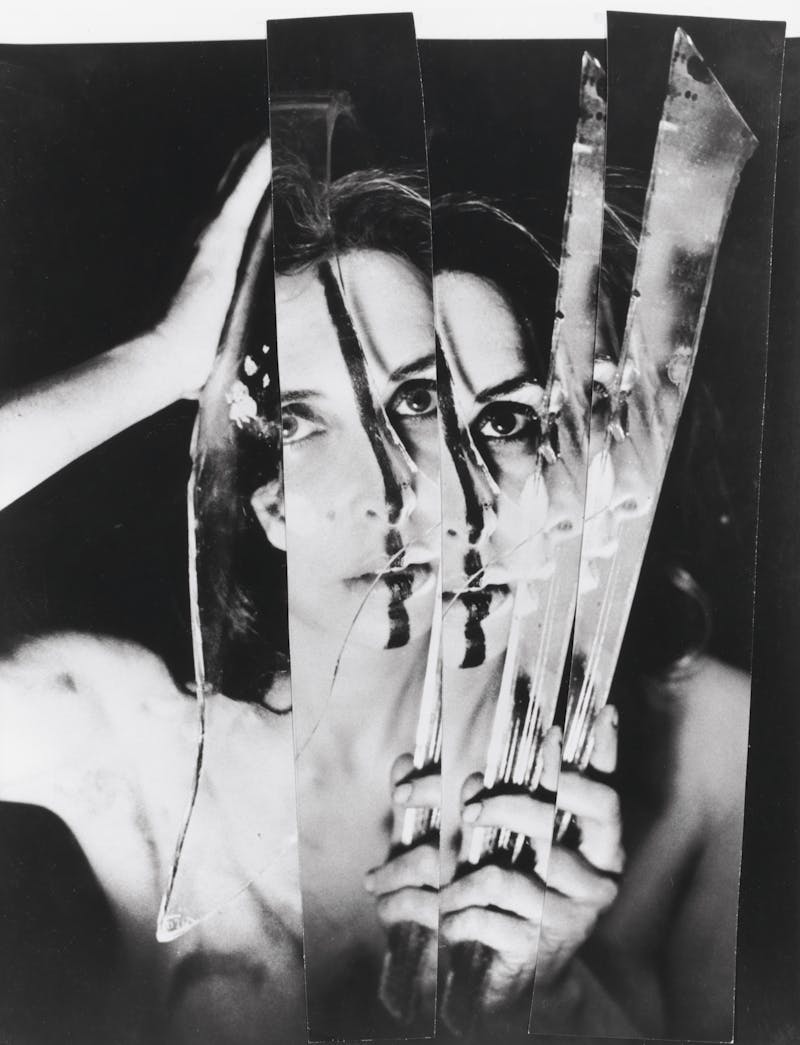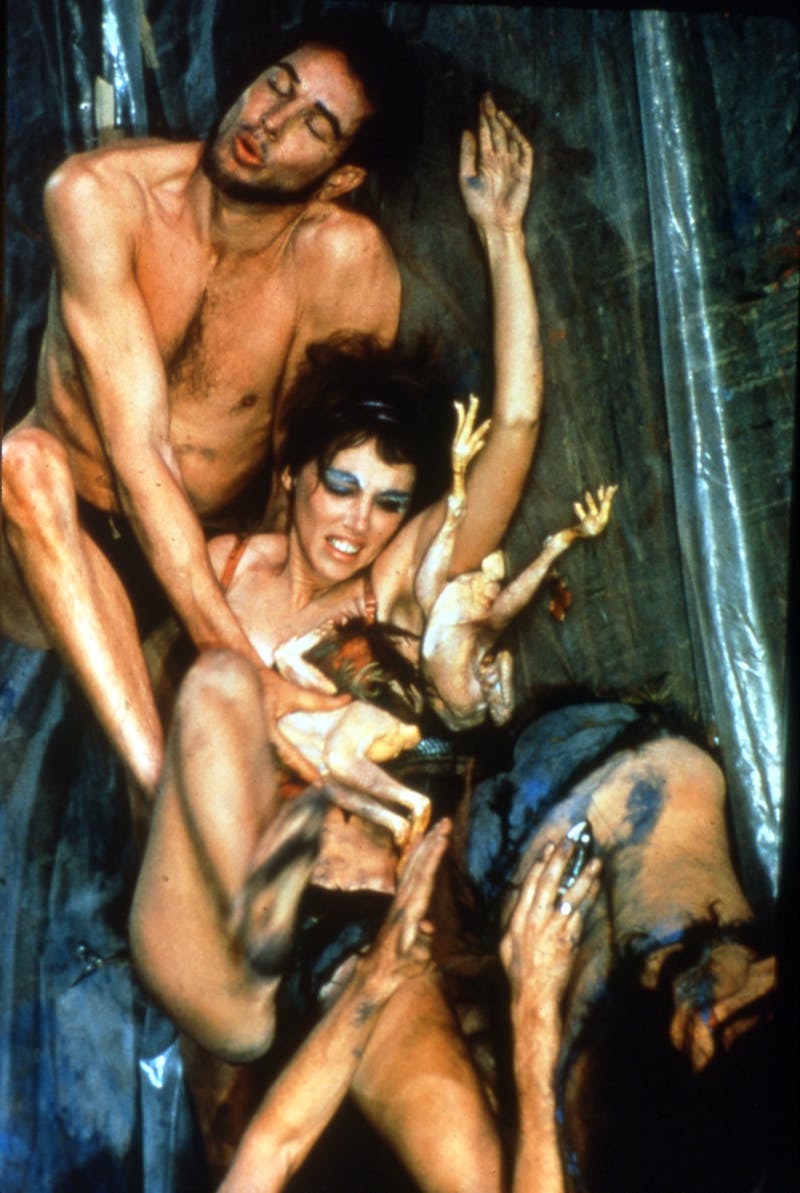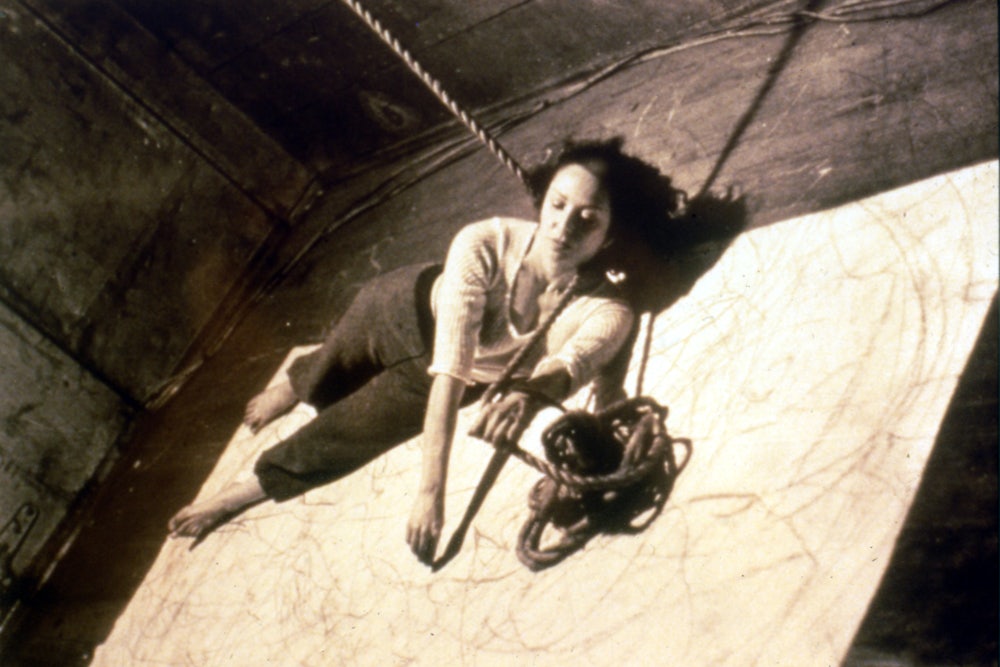If you know one thing about Carolee Schneemann, chances are it’s that, during a performance in the 1970s, she pulled a scroll out of her vagina and read the text on it aloud. She actually did this twice—once in 1975 and again two years later, with a different scroll each time. Those performances, both titled Interior Scroll, have come to define her career.
It’s not hard to see why. The work seems to distill perfectly Schneemann’s concerns over the last more than 60 years: the liberation of the female body, the celebration of the vagina, the possibility for a woman to be both artistic subject and object, the effects of patriarchy and sexism. Both of the texts Schneemann inscribed on her scrolls are drawn from other artworks she’d been working on at the time, but they also function as feminist treatises; both offer sharp commentary on the way women’s work is often belittled. The first, excerpted from her book Cézanne, She Was a Great Painter (1975), reads
if you are a woman (and things are not utterly changed)
they will almost never believe you really did it
(what you did do)
The second, from her film Kitch’s Last Meal (1973–78), recounts a conversation with a “structuralist filmmaker” who dismisses Schneemann’s films for
the personal clutter
the persistence of feelings
the hand-touch sensibility
the diaristic indulgence
the painterly mess
the dense gestalt
the primitive techniques.
The text in those last lines may be fictional, but it sums up in a real way how Schneemann’s work has been dismissed for decades by critics of all kinds, namely men who could not accept her deep-rooted feminism and feminists who found her focus on eroticism misplaced and pornographic.
Schneemann embodies the paradigm of the woman artist who’s deeply, irrefutably influential—last year the Artist’s Institute devoted an issue of its magazine to reproducing a binder she keeps to catalogue the diffusion of her images in the culture—yet remains underacknowledged and underfunded. “I am not the only woman artist with a distinguished history who has no way to sustain her work, nor provide for her future,” Schneemann wrote in a 1999 letter to the MacArthur Foundation that’s included in the magazine. “I’m enclosing a bibliography as well as an exhibition and lecture sheet to clarify this extremely paradoxical history, the punishing facts of this mythic ‘career.’”
That “extremely paradoxical history” also means that only now, at the age of 78, is Schneemann having her first comprehensive retrospective. Titled Carolee Schneemann: Kinetic Painting, the exhibition, which is on view at MoMA PS1, showcases some 300 of her works and still manages to feel incomplete. Yet it goes a long way towards giving Schneemann her due, painting a fuller and more complex portrait of an artist whose best work remains doggedly vital.
Schneemann began her career the same way pretty much anyone interested in pursuing art in the U.S. in the 1950s would: by studying painting. She received a scholarship to Bard College but was there less than a year before being suspended for “moral turpitude,” for painting a series of nude self-portraits—never mind that she’d been encouraged to model nude for the male students. She continued to study art at Columbia University and spent the 1950s contending with Abstract Expressionism, the dominant style of the time. A number of her colorful, semi-abstract canvases filled with swirling, churning strokes are on view at MoMA PS1. They’re neither bad nor exceptional, but they signal the direction in which Schneemann was headed: towards motion. (One painting, Pin Wheel, can even be spun on the wall.)
Schneemann was responding to the core tenet of AbEx: “the view that painting should be conceived as an arena for action rather than a circumscribed field of static representation,” the show’s curator, Sabine Breitwieser, writes in the catalogue. She “asked herself early on what sort of new content the genre might embrace.” Her answers in the 1960s included articles of clothing, photographs, household items, and more, which she incorporated into wall-mounted assemblages and freestanding boxes that contain fierce passages of paint; they call to mind the works of Robert Rauschenberg and Joseph Cornell, respectively. She even experimented with such ephemeral content as fire, by filling small boxes with mirror and glass shards and torn-up photos and briefly setting them aflame for the series Controlled Burning.

But the most important element Schneemann inserted into the field of painting was herself—not a rendering, as she’d done earlier, but her living and moving body. “I wanted my actual body to be combined with the work as an integral material—a further dimension of the construction,” she said. A landmark moment came in 1963, when she covered herself in paint, ropes, grease, and plastic and posed among the assemblages in her studio. The striking black-and-white photographs of Eye Body: 36 Transformative Actions for Camera show a messy but undeniably erotic Schneemann who often looks caught in a trance. It’s hard not to wonder what she was thinking, if she understood at that moment the crucial leap she’d made—from passive, two-dimensional nude to active, three-dimensional naked woman. The question guiding her was: “Could a nude woman artist be both image and image maker?”
Around that time, Schneemann became involved in New York City’s experimental downtown scene. She began making performances that she called “kinetic theater”—scored events for groups of performers that fell somewhere between dance, theater, and happenings. The most famous of these is Meat Joy (1964), a quasi-orgiastic ritual in which nine performers undressed and carried out a series of actions with rope, paint, papers, plastic sheets, as well as raw chickens, mackerel, and hot dogs. One of the biggest challenges of curating past performance works is conveying their power with only documentation to show. But the video of Meat Joy remains stirring. There’s something undeniably discomfiting about watching near-naked performers roll around and rub raw chickens all over their bodies, and in our day and age, any image that creates discomfort without the use of violence seems worth lingering on.
What does get lost, somewhat, is the cultural and political context in which such a performance took place (an issue that could be addressed with better wall text). It can be tempting today to dismiss Meat Joy as a formless act of empty hedonism, but Schneemann rigorously orchestrated it, and she did her other performances, through the use of drawings, which are on display, and a score, which is included in the catalogue. She was exploring aesthetic possibilities and cultural taboos. (Meat Joy apparently so tested taboos that a man tried to strangle Schneemann during its 1964 Paris premiere.) “The cultural surround intensifying my sensuous rituals was motivated in contrast to the endless brutalities of the Vietnam War,” Schneemann wrote. “My propositions of ecstatic connection were in reaction to a government shaped by assassinations and militaristic aggressions.”
Schneemann tackled the Vietnam War head-on in a 1965 film titled Viet-Flakes and a 1967 performance called Snows, which used the former as its “heart and core,” she wrote. In Viet-Flakes a camera zooms in and out on suppressed images of atrocities from the war, set to a soundtrack of cut-up American pop songs and Vietnamese music. It feels a bit too much like a formal exercise to be potent. Snows featured an elaborate set, fake snow, five films projected in 360 degrees, and performers who enacted a series of physically intense actions that included falling, crawling, and grabbing and dragging each other’s bodies. It seems to have been a kind of Gesamtkunstwerk of suffering. Unfortunately, at MoMA PS1 its intensity doesn’t come through, perhaps because video documentation flattens the complex layering of media it contained live.
Schneemann has continued to make work about wars and suffering over the decades—what she calls her “atrocity collection”—including an artist’s book, collages, and more pieces about the 1982 Lebanon War; a series of enlarged images of newspaper photographs of people falling from the Twin Towers on 9/11; and an installation titled More Wrong Things (2000), which consists of TV screens arrayed at different heights and connected by a web of dangling wires. The TVs juxtapose graphic images of political violence with mundane ones from Schneemann’s life—a common technique throughout her oeuvre that doesn’t serve her well. Though it suggests an admirable honesty, an admission that she’s only experiencing these conflicts at a remove, it also centers her in a way that compounds the problem of her atrocity works: They feel lacking in a deep engagement with the sociopolitical realities represented by the images they contain.

Far more successful are what Schneemann calls her “works of pleasure”—pieces like Meat Joy and Fuses (1964–67), a half-hour-long, silent collage film of Schneemann and her then partner and collaborator, James Tenney, making love. Medium-range shots of the couple having sex are interspersed with close-ups of their genitals and, sometimes, the view out of a window or Schneemann’s cat watching the action. The images are provocative, but also tender and bracing. Meanwhile the film shifts from red to purple to bright turquoise or appears scratched or upside-side down, reminding the viewer that this is not a simple documentary; Schneemann shaped the work by burning, baking, cutting, painting, and collaging the film. At MoMA PS1, the installation of Fuses in a small, dark room with theater seats conjures a feeling of illicitness, the thrill of an adult movie theater, but the film is remarkable for the unabashedness of its eroticism and experimentation.
Schneemann’s frank willingness to explore both the liberation and limitations of bodily experience is her greatest strength. In Up to and Including Her Limits (1973–76), she combined it with her roots in painting to create a solo performance in which she hung naked in a harness and drew with crayons on the walls and floors around her. Her brilliant Sexual Parameters Charts (1969–75) catalogue women’s assessments of their sexual experiences with men, surveying everything from partners’ body temperatures to genital sizes and use of words. In her lecture-performance Vulva’s Morphia (1995), Schneemann delivers a caustically funny storybook tale of vulva’s journey to understand how the culture perceives her (“Vulva goes to school and discovers she doesn’t exist,” it begins.) Schneemann doesn’t even confine her investigations to the human body: The photographs in her Infinity Kisses series show grainy, washed-out, often unflattering images of the “deep kisses” delivered to her every morning by her cats. The pictures are so intimate they’re almost alienating; they force us to reconcile the aversion they evoke in the viewer with the love they represent for the artist.
The Infinity Kisses series are important because they represent Schneemann’s continued engagement with the realities of her physical life as she’s gotten older. This helps offset a quandary that comes up while viewing the exhibition: although Schneemann’s bodily experiments were so groundbreaking they got her shunned, they also were likely only possible because she was young, thin, and white. Schneemann is aware of this: she recently told Dazed Digital, “You had to be attractive, or they would laugh you off your page. … being attractive gave us the possibility of subverting the meanings of our bodies as they were predetermined by male culture.” To that end, it’s a shame Kinetic Painting doesn’t include another, rarely seen work that was exhibited last year at P.P.O.W. gallery: Known/Unknown: Plague Column (1995–96), a multimedia installation about Schneemann’s treatment for breast cancer. Among other items, the work contains collaged images and texts about a historical Viennese “plague column,” sculptures of breast implants, and videos of mammograms and amateur porn.
The argument underlying Kinetic Painting is that, for all of her performances, assemblages, films, kinetic sculptures, photographs, and more, Schneemann has remained at heart a painter. This idea comes from Schneemann herself, and it’s not hard to understand why she insists on it: women’s work is all too often dismissed, as she emphasized in Interior Scroll, for “the personal clutter” and “the persistence of feelings.” Schneemann knows her art history; she knows that the way to be taken seriously is to be understood as a formalist. And to the men who’ve long written the textbooks, curated the museum shows, and collected the artworks, being a formalist who’s also a woman who takes off her clothes to make art with her body is just not possible. And so, painter it is.
Yet if there’s one current running through Kinetic Painting—which is not arranged chronologically and sometimes feels jumbled—it’s not painting but the body. The body idolized and brutalized; the body stretched and abstracted, repressed and reimagined. This is where Schneemann’s feminist art springs from: an insistence on knowing and representing herself. In a society still hell bent on controlling women’s bodies, that remains all too radical.
